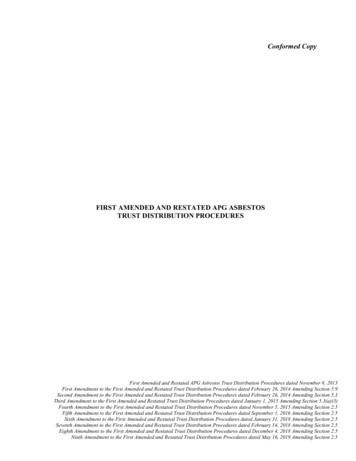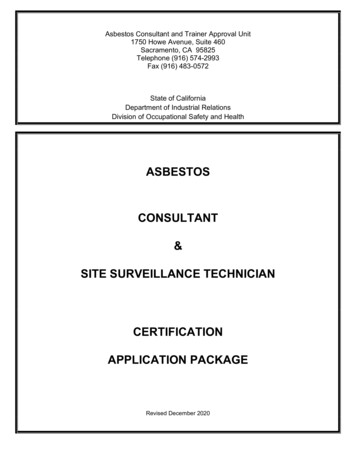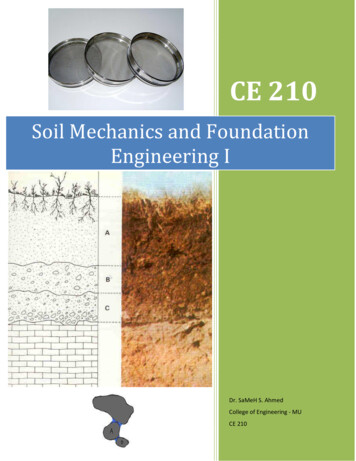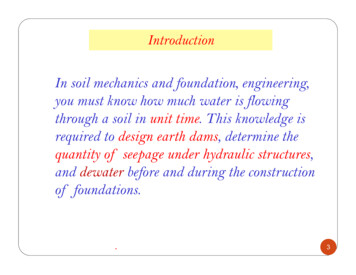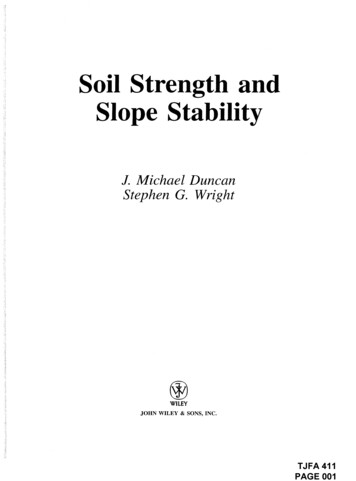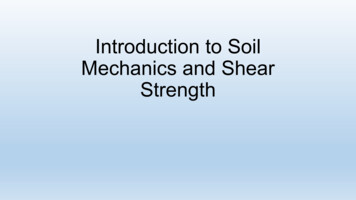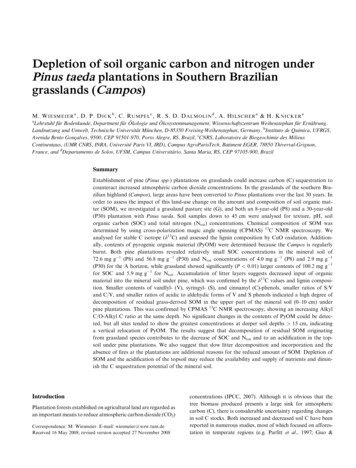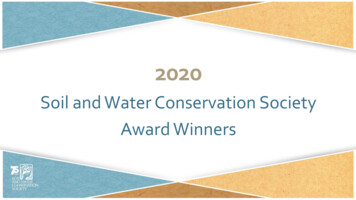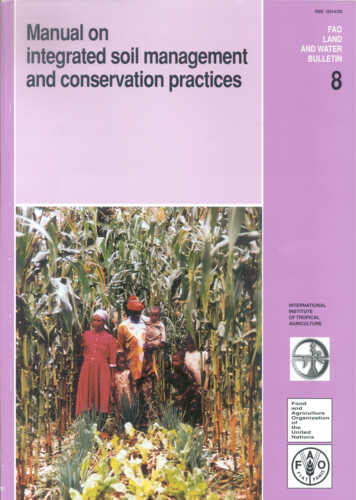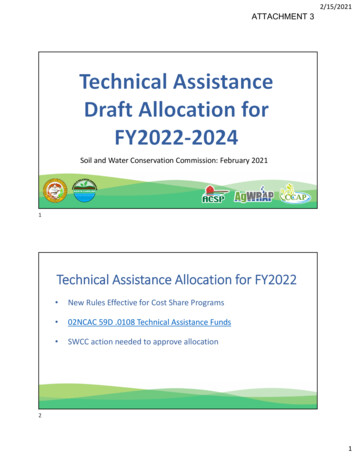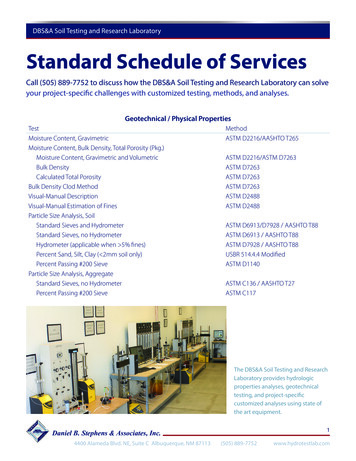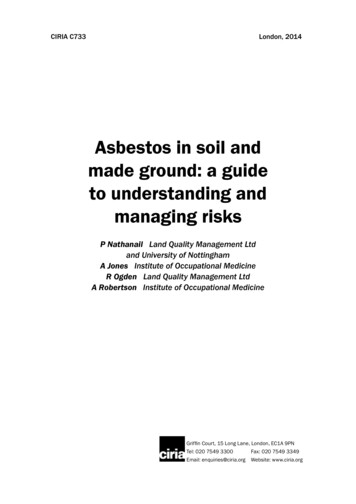
Transcription
CIRIA C733London, 2014Asbestos in soil andmade ground: a guideto understanding andmanaging risksP Nathanail Land Quality Management Ltdand University of NottinghamA Jones Institute of Occupational MedicineR Ogden Land Quality Management LtdA Robertson Institute of Occupational MedicineGriffin Court, 15 Long Lane, London, EC1A 9PNTel: 020 7549 3300Fax: 020 7549 3349Email: enquiries@ciria.orgWebsite: www.ciria.org
Asbestos in soil and made ground: a guide to understanding and managing risksNathanail, C P, Jones, A, Ogden, R, Robertson, ACIRIAC733RP961 CIRIA 2014ISBN: 978-0-86017-737-1British Library Cataloguing in Publication DataA catalogue record is available for this book from the British LibraryKeywordsContaminated land, ground engineering, sustainabilityReader interestClassificationThis guide provides coherent information for clients,landowners or developers and their advisors,regulators and other stakeholders on the safeinvestigation, assessment and remediation of soil andmade ground containing, or suspected of containing,free asbestos fibres or asbestos-containing materials.It contains a digest of contemporary information andguidance with the aim of raising current good danceStatusCommittee-guidedUsers Clients, landowners, developers,house builders, local authorities, otherregulators, consultants and contractorsPublished by CIRIA, Griffin Court, 15 Long Lane, London EC1A 9PN, UKThis publication is designed to provide accurate and authoritative information on the subject matter covered. It is sold and/ordistributed with the understanding that neither the authors nor the publisher is thereby engaged in rendering a specific legal or anyother professional service. While every effort has been made to ensure the accuracy and completeness of the publication, no warrantyor fitness is provided or implied, and the authors and publisher shall have neither liability nor responsibility to any person or entitywith respect to any loss or damage arising from its use.All rights reserved. No part of this publication may be reproduced or transmitted in any form or by any means, includingphotocopying and recording, without the written permission of the copyright holder, application for which should be addressed tothe publisher. Such written permission must also be obtained before any part of this publication is stored in a retrieval system of anynature.If you would like to reproduce any of the figures, text or technical information from this or any other CIRIA publication for usein other documents or publications, please contact the Publishing Department for more details on copyright terms and charges at:publishing@ciria.org Tel: 020 7549 3300.Front cover: Amiandos mine, Troodos, Cyprus. From the archives of Jules Chr. Parisinos 1924–2009 (courtesy Marina Parisinou)iiCIRIA, C733
SummaryThe term ‘asbestos’ relates to several fibrous minerals regulated under UK law that are known to causeserious health effects (including mesothelioma and lung cancer) when inhaled. Asbestos containingmaterials (ACMs) were widely used in construction, and it is difficult (and sometimes not possible) toensure that all asbestos is removed before demolition. Building rubble is liable to contain ACM, and maycontain free fibres. ACM fragments in rubble or soil can be difficult to detect by the naked eye whereasfree fibres in rubble or soil are generally not visible.The Control of Asbestos Regulations (CAR) 2012 requires actions to ensure the protection of workersand general public from asbestos exposures resulting from work activities. However, current case lawsuggests that landowners and developers could find themselves liable for claims under the CompensationAct 2006 in the future, even if CAR and planning requirements have been satisfied. In order to avoidsuch claims, adequate attention needs to be paid to potential risks from asbestos-containing soils (ACSs)during all redevelopment.The concentration of airborne fibres released is influenced by many factors including asbestos type,ACM type and condition/state, depth, distribution and concentration in soil, soil type, and soil moisturecontent. There is limited data on the release of airborne fibres from soils in real world environments, butsoil moisture content has a particularly significant impact. Increasing amounts of fibres are likely to bereleased over time as ACMs deteriorate. Friable ACMs (eg lagging and asbestos insulating board) releasefibres much more easily, and are likely to deteriorate faster, than firmly bound materials (eg asbestoscement), which may take a very long time to degrade, if undisturbed.In principle, the general tiered approach to the assessment and management of potential risks posedby ACSs is the same as that for any other contaminant. However, the unique nature of asbestos meansthat different methods of analysis, exposure estimation and risk estimation are required. Importantly,soil and air analysis methods may need to be more detailed than those currently commonly used todemonstrate compliance with CAR.This guide identifies several key areas of uncertainty in current understanding, and recommendationsare made for future research and policy making in order to address them. However, due to theseuncertainties, the characterisation and assessment of potential risks is not straightforward, with similardifficulties also being encountered in other developed countries. This guide recommends a ‘lines ofevidence’ approach whereby more than one method is used to estimate the airborne fibre concentrationslikely to be generated from soils at the site. Except at low-risk sites, measuring soil concentrations aloneis unlikely to be sufficient. Based on the estimated airborne concentrations, cumulative exposures canbe estimated for exposure scenarios relevant to the site under assessment, and existing exposure-riskmodels are available to indicate the level of risk such exposures may pose. Asbestos in soil thresholdscited for other purposes (such as the hazardous waste threshold and the detection limit mentioned inICRCL, 1990) should not be used for the assessment of risk.The requirements of CAR 2012 and other relevant legislation (eg relating to waste and the carriage ofdangerous goods) need to be complied with throughout. Due to high public awareness of the dangers ofasbestos, effective risk communication will also be required at many affected sites.Asbestos in soil and made groundiii
AcknowledgmentsThe project was carried out under contract to CIRIA by a consortium led byLand Quality ManagementLtd and Institute of Occupational Medicine. This project is funded by Campbell Reith Hill LLP,Research and Development Enabling Fund, National Grid, Crossrail, Chemtest, Hydrock, Peter BrettsAssociates LL, ICE, SNIFFER, Akzonobel, Lucion, RSK, Taylor Wimpey, Redhills and CIRIA Coremembers.AuthorsPaul Nathanail MA(Cantab) MSc DIC PhD EuroGeol CGeol SILCPaul Nathanail is professor of engineering geology at the University of Nottingham and managingdirector of Land Quality Management Ltd. He runs the Nottingham e-learning Masters course incontaminated land management. He is a chartered geologist and Specialist in Land Condition (SiLC).The pioneering work of LQM in developing generic assessment criteria for substances for which noSGV was available revolutionised generic quantitative risk assessment under the planning regime. TheLQM/CIEH Dose Response Roadmaps have since been developed to assist local authorities in evaluatingwhether or not sites pose a significant possibility of significant harm.Alan Jones BSc (Hons) MPhil PhDAlan Jones is a senior consultant at IOM. He has been involved in health and safety research at IOMfor over 30 years, and has assisted or led many studies relating to asbestos. He has worked with a widevariety of clients, including UK Government departments, HSE, Defra, local authorities, US NIOSH, UKand international companies. Alan is currently associated with expert witness work (concerning asbestoslitigation) and provides advice on asbestos in soils and also incidents involving exposures to asbestos.Alan has written over 100 published papers and reports.Richard Ogden BSc (Hons) PhDRichard Ogden is a senior environmental scientist at Land Quality Management Ltd, and has over 10years’ experience in the field of contaminated land assessment and remediation. He gained a degreein biochemistry and marine biology and went on to study the genetic and molecular bottlenecks inthe biological remediation of BTEX, PAHs and PCBs at the University of Wales, Bangor. Richard is amember of the team responsible for the development of the LQM/CIEH Dose Response Roadmaps andboth first and second editions of the LQM/CIEH GAC.Alastair Robertson BSc (Hons) PhDAlastair Robertson has recently retired from his post as a senior consultant at IOM. He was involved inIOM’s research and consultancy relating to health at work and in the general environment for almost40 years. He was a member of IOM’s Board of Management for 18 years and was in charge of IOM’sconsultancy and services work for 10 years. His experience in asbestos in soils extends over 25 years,working more recently on major, ground-breaking projects for both public and private sector clients.Project steering groupRachael AdamsMinistry of Defence (MoD)Bill Baker Independent consultant (representing Chartered Institute ofEnvironmental HealthChris BarrettivArupCIRIA, C733
Jane BeckmannHealth and Safety Executive (HSE)Adam BinneyNetwork RailSeamus Lefroy Brooks LBH Wembley Geotechnical and Environmental (also representingAssociation of Geotechnical and Geoenvironmental Specialists)Stuart ChandlerPeter Brett AssociatesJames ClayCampbell Reith Hill LLPHazel DavidsonDETSClaire DickinsonAECOM (chair)Frank EvansNational GridSteve Forster IEG Technologies UK Limited (also representing EIC-CL:AIRE JointIndustry Working Group on Asbestos in Soil, Made Ground andConstruction & Demolition Materials)Matt HusseyOAMP (formerly Tyser)Paul GribbleALcontrol LaboratoriesMatt GriggsRedhillsSimon HayArcadisIan Heasman Taylor Wimpey (also representing Soil and Groundwater TechnologyAssociationPhil HellierChemtestUrsula LawrenceCrossrailIan MartinEnvironment AgencyDavid RobinsonTransport for LondonPhil RozierLucion Environmental LtdCarl SlaterWatermanChris VincettHydrockPaula WhittellIndependent (formerly Berrymans Lace Mawer)George WilkinsonAkzonobelRebecca WilliamsSNIFFERProject managersChris ChiverrellProject directorJoanne KwanProject managerOther contributorsThe project team would also like to thank many people and organisations who have provided advice andinformation during the project. This includes members of the EIC-CL:AIRE Joint Industry WorkingGroup on Asbestos in Soil, Made Ground and Construction & Demolition Materials, the Soil andGroundwater Technology Association (SAGTA), VSD Avenue (a consortium comprising VolkerStevin Ltd,Sita Remediation NV and DEME Environmental Contractors BV), Charles Feeny, Barrister, St JohnsBuildings, Liverpool, and contributing editor, Pro-Vide-law.co.ukThis guide represents the views of the authors who are grateful for all the comments and suggestionsreceived from the people and organisations listed. However, the authors acknowledge that theinformation presented in this guide does not reflect all the views expressed.Asbestos in soil and made groundv
ContentsSummary . . . . . . . . . . . . . . . . . . . . . . . . . . . . . . . . . . . . . . . . . . . . . . . . . . . . . . . . . . . . . . . . . . . . . . . . . . . . . . . . . . . . . . iiiAcknowledgments . . . . . . . . . . . . . . . . . . . . . . . . . . . . . . . . . . . . . . . . . . . . . . . . . . . . . . . . . . . . . . . . . . . . . . . . . . . . . . ivGlossary . . . . . . . . . . . . . . . . . . . . . . . . . . . . . . . . . . . . . . . . . . . . . . . . . . . . . . . . . . . . . . . . . . . . . . . . . . . . . . . . . . . . . . . ixAbbreviations and acronyms . . . . . . . . . . . . . . . . . . . . . . . . . . . . . . . . . . . . . . . . . . . . . . . . . . . . . . . . . . . . . . . . . . . . . xi1Introduction . . . . . . . . . . . . . . . . . . . . . . . . . . . . . . . . . . . . . . . . . . . . . . . . . . . . . . . . . . . . . . . . . . . . . . . . . . . . . . . 11.11.21.31.41.51.61.72Aim . . . . . . . . . . . . . . . . . . . . . . . . . . . . . . . . . . . . . . . . . . . . . . . . . . . . . . . . . . . . . . . . . . . . . . . . . . . . . . 2Objectives . . . . . . . . . . . . . . . . . . . . . . . . . . . . . . . . . . . . . . . . . . . . . . . . . . . . . . . . . . . . . . . . . . . . . . . . 2Structure of the guide . . . . . . . . . . . . . . . . . . . . . . . . . . . . . . . . . . . . . . . . . . . . . . . . . . . . . . . . . . . . . . . 2What are ‘soil’ and ‘made ground’? . . . . . . . . . . . . . . . . . . . . . . . . . . . . . . . . . . . . . . . . . . . . . . . . . . . . 3Legal context . . . . . . . . . . . . . . . . . . . . . . . . . . . . . . . . . . . . . . . . . . . . . . . . . . . . . . . . . . . . . . . . . . . . . . 4Units of measurement . . . . . . . . . . . . . . . . . . . . . . . . . . . . . . . . . . . . . . . . . . . . . . . . . . . . . . . . . . . . . . 4Function and Limitations of the guide . . . . . . . . . . . . . . . . . . . . . . . . . . . . . . . . . . . . . . . . . . . . . . . . . . 5Client requirements for assessment and management of risks . . . . . . . . . . . . . . . . . . . . . . . . . . . . . . . . . . 62.12.22.32.42.52.62.72.82.92.102.112.12
A catalogue record is available for this book from the British Library Keywords Contaminated land, ground engineering, sustainability Reader interest This guide provides coherent information for clients, landowners or developers and their advisors, regulators and other stakeholders on the safe investigation, assessment and remediation of soil and made ground containing, or suspected of .

